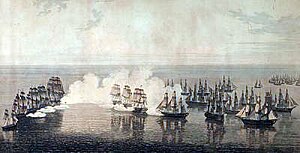Battle of Pulo Aura
| Battle of Pulo Aura | |||||||
|---|---|---|---|---|---|---|---|
| Part of the Napoleonic Wars | |||||||
 Commodore Dance's Indiamen (centre), protecting the merchant fleet (right), engage Admiral Linois's squadron (left). William Daniell, 1804 |
|||||||
|
|||||||
| Belligerents | |||||||
|
|
|
||||||
| Commanders and leaders | |||||||
| Nathaniel Dance | Charles-Alexandre Durand Linois | ||||||
| Strength | |||||||
| 16 East Indiamen, 12 Country ships and a Portuguese merchant ship; accompanied by armed brig Ganges | Ship of the line Marengo, 2 frigates, a corvette and an armed brig | ||||||
| Casualties and losses | |||||||
| 1 killed, 1 wounded | None | ||||||
The Battle of Pulo Aura was a minor naval engagement of the Napoleonic Wars, fought on 14 February 1804, in which a large convoy of Honourable East India Company (HEIC) East Indiamen, well-armed merchant ships, intimidated, drove off and chased a powerful French naval squadron. Although the French force was much stronger than the British convoy, Commodore Nathaniel Dance's aggressive tactics persuaded Contre-Admiral Charles-Alexandre Durand Linois to retire after only a brief exchange of shot. Dance then chased the French warships until his convoy was out of danger, whereupon he resumed his passage towards British India. Linois later claimed that the unescorted British merchant fleet was defended by eight ships of the line, a claim criticised by contemporary officers and later historians.
The battle occurred during an extended commerce raiding operation by a French squadron led by Linois in the ship of the line Marengo. Linois had sailed to the Indian Ocean in 1803 before the declaration of war, under orders to install garrisons in the French and Dutch colonies in the region and to prey on lightly defended British merchant shipping. One of the richest and most significant targets was the "China Fleet", an annual convoy of East Indiamen from China and other Far Eastern ports that carried millions of pounds worth of trade goods. Although these large vessels were accompanied by numerous smaller merchant ships, news of the outbreak of war had only just arrived in the Pacific and the only warship available to defend the fleet was the small HEIC armed brig Ganges. Dutch informants notified Linois of the fleet's destination and date of departure from Canton while he was anchored at Batavia on Java, and he sailed in search of the convoy on 28 December 1803, eventually discovering it in early February.
...
Wikipedia
